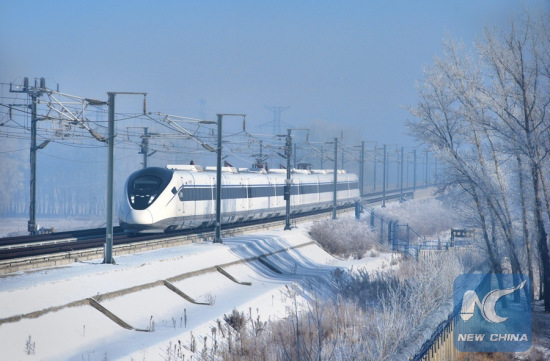
File photo taken on Feb. 14, 2015 shows a CRH2G bullet train running for a test on the Harbin-Dalian high-speed railway, northeast China. (Photo/Xinhua)
China's economy will tend towards L-shaped growth as deep-rooted problems persist and new challenges emerge, according to an exclusive interview with an "authoritative figure," a term usually reserved for high-ranking officials, in The People's Daily on Monday.
The article ruled out the possibility of a quick, strong recovery, and suggested that the economy may tick over at a moderate level for years to come.
LOOMING RISKS
The source said that although growth has been stable and "within expectations," underlying problems persist, with some emerging problems "bigger than expected."
The article acknowledged risks including shrinking private investment, the real estate bubble, industrial overcapacity, non-performing loans, local government debt and financial market risk.
Volatility in the stock and FX markets early this year reflected some of the overall vulnerability of the financial system, the source said. High leverage was called the "original sin" that had led to increased risk in FX, stocks, bonds, real estate and bank credit.
"High leverage will definitely bring high risk." If not controlled properly, systemic financial risks could precipitate an economic recession and even wipe out ordinary people's savings.
Deleveraging should be a priority, and the "fantasy" of stimulating the economy through monetary easing should be abandoned. Rising bad loans need to be met head on rather than kept hidden.
GDP slowed to 6.7 percent in the first quarter, the lowest since the dark days of the global financial crisis in 2009. Significantly, the warning comes just as signs of stabilization have begun to appear, with state investment in infrastructure growing and bank lending at a record high.
SUSTAINABLE PATH
Keen to avoid a short-term bonus at the price of long-term damage, China has repeatedly stated that there will be no massive stimulus to boost growth. Supply-side structural reform -- essentially cutting overcapacity and shifting into higher value-added manufacturing -- is a harder path to set out upon, but regarded as a much more sustainable one. "Supply-side structural reform is a lifeline for us in avoiding the middle-income trap. It is a battle we cannot afford to lose," the source said.
What needs to be done, according to the interviewee, is a further pruning of industrial overcapacity; the closure of "zombie" companies; overall reform of the labor market; faster changes to the household registration system; reduced taxes and more innovation.
Overcapacity cannot sustain growth and the problem should be solved sooner rather than later. The longer reform waits, the more costly and painful it becomes.
If overcapacity is to be reduced and "zombie" enterprises eliminated, it should be through mergers and revamps rather than bankruptcy. "Zombie" companies beyond salvage should be allowed to fail because debt-to-equity swaps would be costly and "self-deceptive." Caring for workers who are laid-off, and finding them new jobs, is of the utmost importance.
Both supply-side reform and demand-side support are needed, but balanced and coordinated, in different stages and with a different focus.
The stock, FX and real estate markets should return to their natural functions, instead of being used as means of maintaining growth, according to the interviewee.
RECOVERY HOPES
Despite slowing growth and rising risk, the economy has huge potential, high resilience and ample leeway. Growth will not plunge precipitously, even without a stimulus, the source observed.
Although Q1 GDP growth slowed, employment remained stable, incomes continued to increase and progress was made in restructuring. The official manufacturing purchasing managers' index (PMI) stood at 50.1 in April, just above the 50 mark that separates expansion and contraction, for the second straight month.
Transition is underway. Consumption made a bigger contribution than investment to growth in Q1, while services expanded 7.6 percent, now accounting for 56.9 percent of GDP.
The IMF last month raised its forecast for China's economic growth in the near term and said a successful rebalancing of the economy was likely. The fund now expects China's GDP to grow 6.5 percent in 2016, up from its January estimate of 6.3 percent.


















































